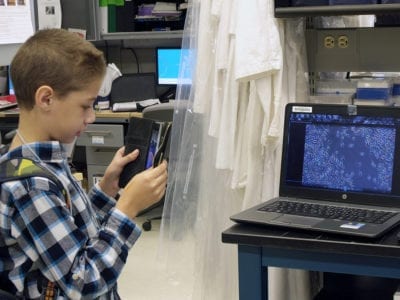Today we’d like to raise awareness for a lesser known eosinophilic condition, eosinophilic gastritis (EG), one of a handful of eosinophilic gastrointestinal disorders (EGIDs).
When families receive a diagnosis for any one of these EGIDs, it can be overwhelming for many reasons. But the good news is that diagnosis, treatment and understanding are advancing.
What is eosinophilic gastritis?
EG is having too many eosinophils in the stomach, causing pain and inflammation. When the body wants to attack a substance, such as an allergy-triggering food or airborne allergen, eosinophils respond by moving into the area and releasing a variety of toxins. However, when the body produces too many eosinophils, they can cause chronic inflammation resulting in tissue damage. There is currently no cure for EGIDs. One of the main treatments is to eliminate the foods that are causing the reaction.
Diagnosis, treatment and understanding of eosinophilic esophagitis (EoE), the most common EGID, has improved greatly in the last decade. However, making similar advances in EG is more challenging.
The Challenge of Eosinophilic Gastritis
Patients with EG may have a challenging, long journey to correct diagnosis and then effective treatment. Two major reasons being that there are not standardized diagnostic criteria for EG and little is known about the causes of EG. These difficulties are largely due to EG being very rare and most patients with EG having other EGIDs. Only 1 in 5,500 patients have an EGID that is not EoE, and even fewer have EG by itself. With fewer individuals to treat and study, we have fewer opportunities to learn more about this condition and draw conclusions.
Similar challenges are also present for eosinophilic colitis (EC) and eosinophilic gastroenteritis (EGE), which has eosinophils and inflammation in multiple areas of the gastrointestinal tract.
Many of our patients and families come to our center having faced these basic challenges. Recently, Johnnie Simmes and his mother, Autumn, visited our center and the Rothenberg Lab to make a video about EGIDs to increase awareness of these conditions at Johnnie’s school. Autumn shared their challenges in diagnosis and care, which is similar to many of our patients:

“[Our previous doctors] had never seen a case like his before,” says Autumn Simmes, the mother of 9-year-old Johnnie, who was diagnosed with EGE at age 1. “It was difficult not having a team that was sure about what to do next.” Johnnie and his family moved several states to be closer to specialized care at Cincinnati Children’s. “Johnnie went for years without having a single food. It was hard. But now we’re on a good track. He’s running around like a normal third grader.”
Hope Through Research for Eosinophilic Gastritis
Here at our center, most of our patients with EG also have EoE. However, our patients with EoE usually only have EoE instead of EoE with another EGID. Why is EG more commonly found with other eosinophilic inflammation and EoE more often found in isolation?
With the collaborative resources of Consortium for Eosinophilic Gastrointestinal Disease Researchers (CEGIR), we are working to discover how EoE, EC and EG relate to each other and what this means for diagnosis, treatment and patients. We are conducting a long-term study to learn more about EGIDs and how they are alike and different. We are also conducting a pilot study for EG in which dietary therapies are being tested.
In the lab, we are examining genetic differences between the stomach tissue of patients with and without EG. By discovering genes with altered structure or expression, we can identify pathways that are different in the stomach of patients with EG, which will allow further understanding of the causes of EG. The pathways identified in the lab may also serve as future targets for treatment of EG. We published a characterization of EG in 2014.
One of the molecules that was highly increased in the stomach of patients with EG was cadherin-like 26 (CDH26). Cadherins can be thought of as Velcro between cells, with each cadherin protein acting like a hook that snags cadherin on other cells. This attaches cells to each other. CDH26 was also increased in the esophagus of patients with EoE, so it may have a common function in different types of EGIDs. We published about CDH26 in 2017.
I hope that by identifying how factors that are differentially regulated in EGIDs, such as CDH26, may be involved in these diseases, we can develop better diagnostic tools and treatments related to these molecules. Using our prior studies and the current collaborative studies as a basis, we look forward to continuing to research EG and other EGIDs to make progress toward understanding their causes and how to treat them.
We hope that you will join us in spreading awareness for EG so that we can increase our understanding of the disease and ultimately bring hope to patients facing this condition.
To learn more about our Center for Eosinophilic Disorders please call 513-636-2233 or email cced@cchmc.org
Editor’s note: Julie Daisey, MS, also contributed to this blog post. She is the program manager at the Cincinnati Center for Eosinophilic Disorders. Julie coordinates the center’s outreach programming and patient-family events. She has been with Cincinnati Children’s for 10 years and resides in Cincinnati with her husband and 8-year old son.







It is great to hear of research happening for the lower EGID’s. we are in the UK and my 10yr old son was diagnosed with eosinophilic enterocolitis at age 5. Sadly we have learned nothing more about this disease in the last five years although it is heartening to see such strides made for EoE.
Good luck!!